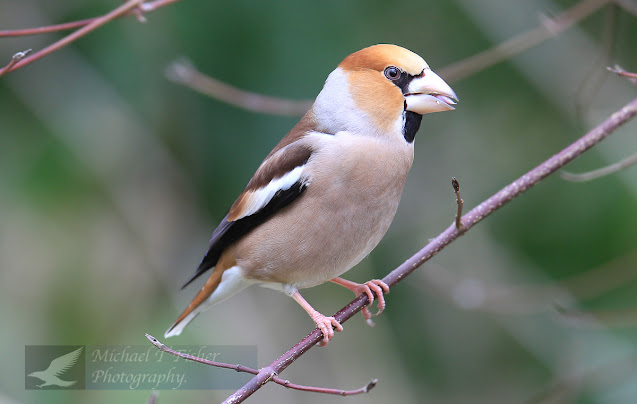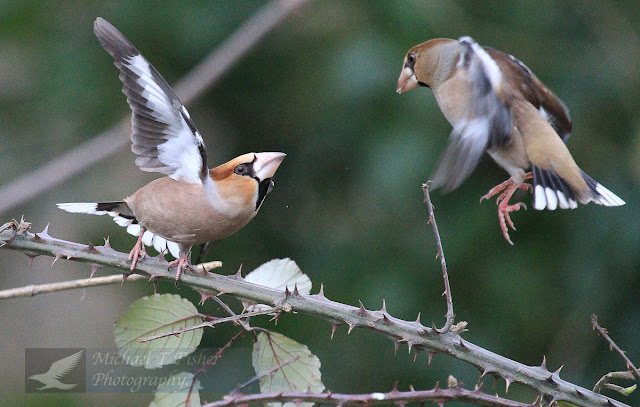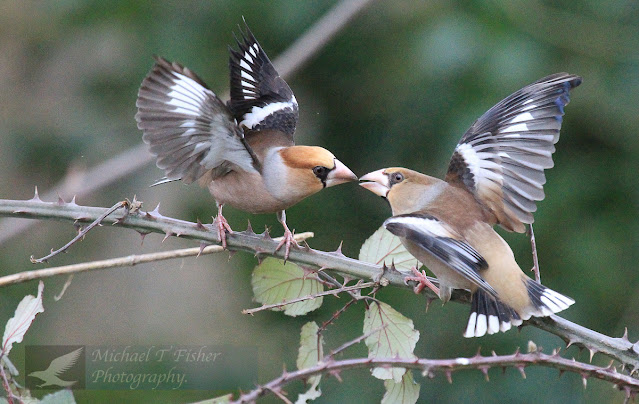The Hawfinch is a large, charismatic, but shy bird. This elusive bird spends much of its time high in the treetops of broad-leafed woodland, avoiding the open ground.
With its large and mighty bill, its large head and neck are adapted to accommodate the muscle that helps generate a staggering 45kg of force. This muscle is used for cracking open Cherry and Olive stones to extract the inner seed, all the more impressive from a bird weighing in at a mere 2oz.
Generally, it is a nonmigratory bird, although Northern birds move South of their breeding range. It is the wintertime that we see them in large flocks foraging on open farmland and perhaps mixed with flocks of mixed passerines, Chaffinches, Bramblings Greenfinches, etc., who have also moved south in search of food.
With its large and mighty bill, its large head and neck are adapted to accommodate the muscle that helps generate a staggering 45kg of force. This muscle is used for cracking open Cherry and Olive stones to extract the inner seed, all the more impressive from a bird weighing in at a mere 2oz.
Generally, it is a nonmigratory bird, although Northern birds move South of their breeding range. It is the wintertime that we see them in large flocks foraging on open farmland and perhaps mixed with flocks of mixed passerines, Chaffinches, Bramblings Greenfinches, etc., who have also moved south in search of food.
The Male, with its coloured Winter bill, changes to a blue Black colour in Summer.
Here, the Female is duller in colour and has a grey patch on the wing.
In the breeding season, part of the Male mating ritual is to raise its head and chest feathers; the head feathers also rise when alert to disturbance or danger.
Standing tall in the Winter treetop.
A Female looks down on a Blue Tit.
Here, we can see the Iridescent blue flight feathers; once again, he will drop his wings at the breeding time, displaying this beautiful colour to his new partner.
Except for the nesting period, Hawfinches are particularly pugnacious birds. Because their winter feeding takes place on the ground, they also give each other space. While carrying out this study, I observed a small flock of six birds having their feeding station invaded by a flock of eight birds.
What followed was quite incredible. One female bird tried for forty minutes to remove all the newcomers.
Interestingly, bill kissing is part of the mating ritual; it can begin as early as mid-February, so I was initially unsure what was happening here!
It is said that aggressive and defensive posturing is associated with the possession of perching space and food. This is heightened as the days start to lengthen. However close we are to St Valentine's Day, this is combative aggression, not affection!
The following day, still in the presence of the fourteen Hawfinches, I found "Bruiser" his bill had suffered some damage from the affray!
If a Hawfinch is disturbed, it flies up through the tree, perching high in the tree canopy and descends branch by branch, keeping an eye on the surroundings.
This happens when this Male finds another male bird on its stamping ground.
110 lbs of pressure on that bill.
Inside, the bills are jagged to help hold the fruit stones.
The clash is over quickly.



















No comments:
Post a Comment